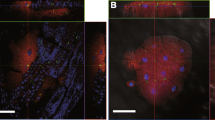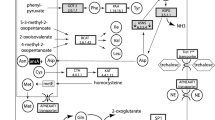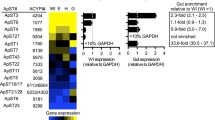Abstract
Specialized cells within the aphid,Schizaphis graminum, contain intracellular, vesicleenclosed eubacterial endosymbionts (Buchnera aphidicola). Using oligonucleotide probes derived from conserved sequences of the ATP synthase β-subunit and glyceraldehyde-3-phosphate dehydrogenase, and the polymerase chain reaction (PCR), we have amplified, cloned, and sequenced three DNA fragments. Amino acid sequence similarity indicated that two of these fragments corresponded to endosymbiont and host genes potentially coding for the β-subunit of ATP synthase. The host gene fragment contained two putative introns. The third DNA fragment corresponded to a portion of a gene coding for a glyceraldehyde-3-phosphate dehydrogenase that was highly related to one of the enzymes fromEscherichia coli (GapA). These results indicate thatB. aphidicola may have an ATP synthase and consequently could synthesize ATP from a proton motive force generated within the intracellular vesicles of host cells containing the endosymbionts. The detection of a gene fragment coding for a protein similar to glyceraldehyde-3-phosphate dehydrogenase suggests the presence of this glycolytic enzyme in the endosymbiont and its involvement in energy-yielding metabolism.
Similar content being viewed by others
Literature Cited
Alefounder PR, Perham RN (1989) Identification, molecular cloning and sequence analysis of a gene cluster encoding the class II fructose 1,6-biphosphate aldolase, 3-phosphoglycerate kinase and a putative second glyceraldehyde 3-phosphate dehydrogenase ofEscherichia coli. Mol Microbiol 3:723–732
Amann R, Ludwig W, Schleifer KH (1988) β-subunit of ATP-synthase: a useful marker for studying the phylogenetic relationships of eubacteria. J Gen Microbiol 134:2815–2821
Breen GAM, Holmans PL, Garnett KE (1988) Isolation and characterization of a complementary DNA for the nuclearcoded precursor of the β-subunit of bovine mitochondrial F1-ATPase. Biochemistry 27:3955–3961
Branlant G, Branlant C (1985) Nucleotide sequence of theEscherichia coli gap gene. Different evolutionary behavior or the NAD+-binding domain and of the catalytic domain ofd-glyceraldehyde-3-phosphate dehydrogenase. Eur J Biochem 150:61–66
Campbell BC (1990) On the role of microbial symbiotes in herbivorous insects. In: Bernays EA (ed) Insect-plant interactions, vol I. Boca Raton, Florida: CRC Press, Inc., pp 1–44
Clark MA, Baumann L, Baumann P (1992) Sequence analysis of an aphid endosymbiont DNA fragment containingrpoB (β-subunit of RNA polymerase) and portions ofrplL andrpoC. Curr Microbiol 25:283–290
Clark MA, Baumann L, Munson MA, Baumann P, Campbell BC, Duffus JE, Osborne LS, Moran NA (1992) The eubacterial endosymbionts of whitefies (Homoptera: Aleyrodoidea) constitute a lineage distinct from the endosymbionts of aphids and mealybugs. Curr Microbiol 25:119–123
Conway T, Sewell GW, Ingram LO (1987) Glyceraldehyde-3-phosphate dehydrogenase gene fromZymomonas mobilis: cloning, sequencing, and identification of promoter region. J Bacteriol 169:5653–5662
Douglas AE (1989) Mycetocyte symbiosis in insects. Biol Rev 64:409–434
Hensel R, Zwickl P, Fabry S, Lang J, Palm P (1989) Sequence comparison of glyceraldehyde-3-phosphate dehydrogenases from the three urkingdoms: evolutionary implication. Can J Microbiol 35:81–85
Houk EJ (1987) Symbionts. In: Minks AK, Harrewijn P (eds) Aphids; their biology, natural enemies, and control, vol 2A. Amsterdam: Elsevier Biomedical Press, pp 123–129
Ishikawa H (1989) Biochemical and molecular aspects of endosymbiosis in insects. Int Rev Cytol 116:1–45
Lai C-Y, Baumann P (1992) Genetic analysis of an aphid endosymbiont DNA fragment homologous to thernpA-rpmH-dnaA-dnaN-gyrB region of eubacteria. Gene 113:175–181
Lai C-Y, Baumann P (1992) Sequence analysis of a DNA fragment ofBuchnera aphidicola (endosymbiont of aphids) containing genes homologous todnaG, rpoD, cysE, andsecB. Gene 119:113–118
Lawrence JG, Ochman H, Hartl DL (1991) Molecular and evolutionary relationships among enteric bacteria. J Gen Microbiol 137:1911–1921
Lewin B (1990) Genes IV. Oxford: Oxford University Press, pp 595–600
Michels PAM, Marchand M, Kohl L. Allert S, Wierenga RK, Opperdoes FR (1991) The cytosolic and glycosomal isoenzymes of glyceraldehyde-3-phosphate dehydrogenase inTrypanosoma brucei have a distant evolutionary relationship. Eur J Biochem 198:421–428
Munson MA, Baumann P, Kinsey MG (1991a)Buchneara gen. nov. andBuchnera aphidicola sp. nov., a taxon consisting of the mycetocyte-associated, primary endosymbionts of aphids. Int J Syst Bacteriol 41:566–568
Munson MA, Baumann P, Clark MA, Baumann L, Moran NA, Voegtlin DJ, Campbell BC (1991b) Evidence for the establishment of aphid-eubacterium endosymbiosis in an ancestor of four aphid families. J Bacteriol 173:6321–6324
Munson MA, Baumann L, Baumann P (1992)Buchnera aphidicola, the endosymbiont of aphids, contains genes for four ribosomal RNA proteins, initiation factor-3, and the α-subunit of RNA polymerase. Curr Microbiol 24:23–29
Padget RA, Grabowski PJ, Konarska MM, Seiler S, Shart PA (1986) Splicing of messenger RNA precursors. Annu Rev Biochem 55:1119–1150
Sharp PA (1987) Splicing of messenger RNA precursors. Science 235:766–771
Sharp PA (1987) Nutritional physiology. In: Minks AK, Harrewijn P (eds) Aphids; their biology, natural enemies, and control, vol 2A. Amsterdam: Elsevier Biomedical Press, pp 99–121
Walker JE, Saraste M, Gay NJ (1984) Theunc operon. Nucleotide sequence, regulation and structure of ATP-synthase. Biochim Biophys Acta 768:164–200
Williamson LR, Plano GV, Winkler HH, Krause DC, Wood DO (1989) Nucleotide sequence of theRickettsia prowazekii ATP/ADP translocase-encoding gene. Gene 80:269–278
Author information
Authors and Affiliations
Rights and permissions
About this article
Cite this article
Clark, M.A., Baumann, P. Aspects of energy-yielding metabolism in the aphid,Schizaphis graminum, and its endosymbiont: Detection of gene fragments potentially coding for the ATP synthaseβ-subunit and glyceraldehyde-3-phosphate dehydrogenase. Current Microbiology 26, 233–237 (1993). https://doi.org/10.1007/BF01577382
Issue Date:
DOI: https://doi.org/10.1007/BF01577382




